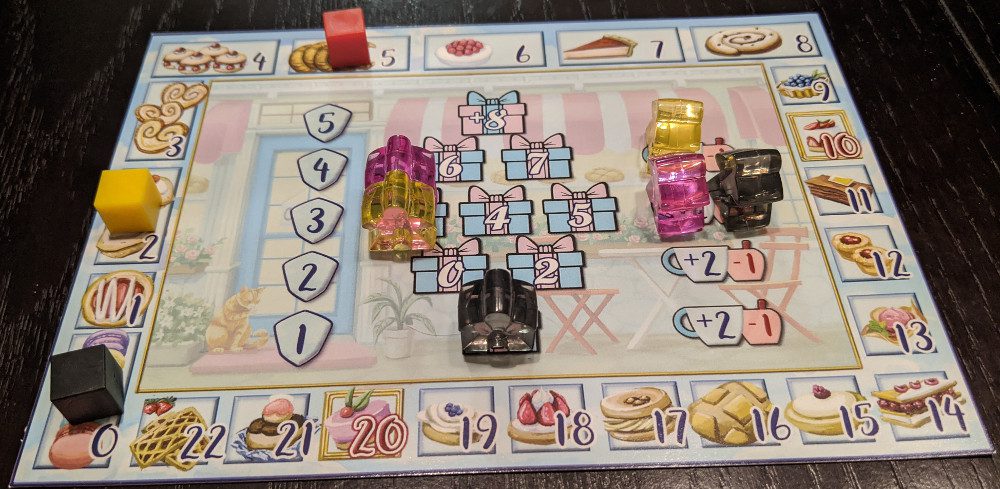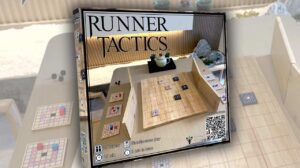Even though we are in a glowing age of board games, trick-taking is still stuck in the corner, barely getting the spotlight it deserves. Go to any trick-taking game on BoardgameGeek, and you will witness dozens of comments blasting it for being too random or casual. It’s unfortunate that this is the case because we have seen numerous innovations to the genre over the years, such as the no-talk co-operative trick-taking game The Crew.
Macaron’s ambitions are to rewrite the script of trick-taking games like Euchre and Bridge. Like the games of old, you will lead a trick by playing a card, and everyone must follow suit with the highest numbered card winning the trick. This is played over a series of rounds until a certain point threshold is met, such as 20 points. There aren’t any weird cards or hierarchy of suits.
That’s where the classical bits end. Yes, it still has a Trump suit, although there are now a pair Trump suits instead of just one, and there is now an Allergen suit. In short, this suit kills a trick. There is still a “winner” of the trick, but it has no point value. While this is an interesting twist by itself, it gets more intriguing with the 2 and 1 cards. Every single “2” card neglects the Allergen suit, and any “1” card used to win a trick becomes three tricks instead of one. Another twist is a round can prematurely end when someone hits 8 tricks or higher.

Sweet Formula
Okay, so we have an interesting relationship with these cards. This wouldn’t work with a standard deck, so what’s changed? The structure of the deck is dependent on the number of players. For the sake of simplicity, let’s say we are playing a three-player game. In a three-player game, there are six suits with numbers 1 to 7, and you start with a hand of 13 cards.
The end result of such a deck is you will have a hand of cards where you might be missing a suit or a limited number of cards of one particular suit. As you would assume in a trick-taking game, if the leading suit is the one you don’t have, you can play any card. This is where the Allergen and Trump suits come into play, and the mask of this game finally slips off.
There is far more headbutting here than most trick-taking games, yet it isn’t so chaotic where strategic and tactical play don’t play a part. It’s also one of the few games allowing you to express your personality through its mechanisms. Once you intentionally shred a suit or two from your hand, a basket of opportunities opens and allows you to play your Allergen or Trump cards to mess with everyone’s expectations and strategies. It’s a nice little touch that I find missing in most modern trick-taking games.
Even how you score points is a departure from the conventional formula. Instead of bidding on a number of tricks, you score points depending on the range you fall into. For example, if you won 3-5 tricks, you score 3 points, while 6-7 tricks score 4 points. Before playing the first card, everyone has the option of placing a bet. They will select a particular range of tricks they think they will land on. If they land on that range, they score bonus points, while failing to hit that range means you reduce the points you’ve won.

Timing The Perfect Play
I love this aspect since it makes the “1” card a ticking time bomb for anyone trying to hold onto it until the very end where they could potentially overshoot their bet. It also throws in risk evaluation into the mix since betting is completely optional, forcing you to take risks or go conservative. Despite all of these changes, it still maintains the integrity of classical contract bidding games.
I have to admit that my first impressions were lukewarm at first. I felt the game tried way too hard to be different by throwing all these rules into a blender. Like an unfamiliar shake, it took a few bites to get used to it. After a few rounds and internalizing all these changes to the formula, I appreciated the type of experience the game is trying to communicate. The card play, scoring, and betting all synchronize together like a popular boy band.
I can’t say the same about how players pick the Trump and Allergen suits though.

Inconsistent Experience
In a two or three player game, it’s nothing out of the ordinary as the players themselves will pick the suits. If you play with three people, the second player picks Trump, and the third player picks the Allergen. That’s easy and to the point. So far, so good.
Four or five players have a voting segment.
This is such a tonal whiplash that I could file an insurance claim. The idea behind this is the players will pick the suits as a group. Everyone gets random voting tokens with various numbers and starting with one player and going clockwise, you put a face-down vote token one at a time to make a suit either a Trump or Allergen. After placing all the tokens, you flip them faceup. The highest number is the Trump suit, while the lowest is the Allergen suit.
My main problem with this setup is the pacing. Trick-taking games aren’t known for being slow, so shoving in a voting system where it could take several minutes to complete doesn’t make sense to me.
Because you get random voting tiles, this means your influence will vary from round to round. Since players will vote based on what is in their hand, you could have a situation where everyone’s votes align with you or against you. In other words, it’s random, and this ritual of pretending you have a choice feels like wasted effort. It would’ve been far better to draw two random cards for the suits or use the previously mentioned three-player method.

In a partnership setting, which this game does have, this system makes sense. Much like bidding contracts in Bridge, the voting allows you to communicate and collaborate with your partner. Not only are you getting intel about your partner’s hand, but you are gathering information about the rival team as well. Even if the voted suits aren’t favorable to your hand, at least you got some useful information out of the process. Unlike the four or five player free for all, there is a purpose behind this, and it works.
That’s my only major criticism. Sure, I could talk about the graphical design needing some work, such as the font used on the cards or the fiddly nature of tracking tricks on the scoreboard, but those are minor issues. As for the card play and mechanisms, it works well, and this is something I can easily slide into any game night due to its simple rules. It still has the engaging tactical play as you would expect in a trick-taking game with some intriguing innovations such as the Allergen suit or scoring based on a range of tricks. I can easily see this game being enjoyable for any fans of trick-taking once they are accustomed to the many changes.











Add Comment